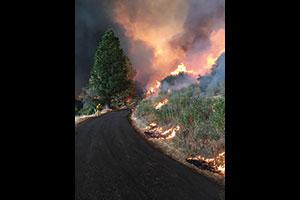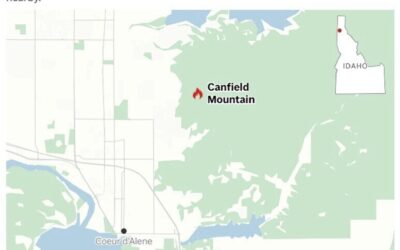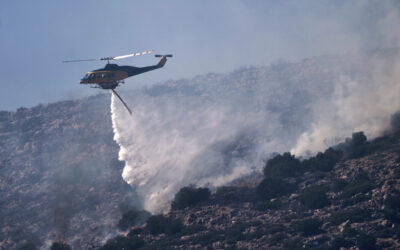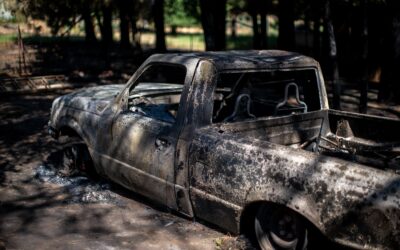First-arriving resources have far less time to accurately size up the expanding incident, implement strategic objectives, and direct tactical actions that result in a positive outcome.
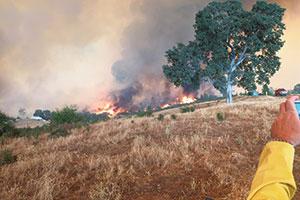
All in command positions need to have a plan they can implement to react to the change in the incident. (Photos by author.)
TODD MCNEAL | From the May 2016 Issue of FireRescue Magazine
Over the past three decades, large destructive wildland fires in communities across our nation have risen to a level of intensity and frequency never before experienced by the fire service. Every fire season, the media broadcasts images of large fires raging in the wildland urban interface/intermix (WUI) with no regard for civilian or firefighter lives, property losses, or jurisdictional boundaries. While there are many factors that contribute to this fact and the related implications, one undeniable and worrisome outcome is the increased risk to firefighters suppressing these fires.
Elevated Threat
WUI fires are moving faster, spotting farther, and demonstrating fire behavior more extreme than fires in the past. This translates into much higher complexity, increased risks, and elevated potential loss for first-arriving chief and company officers. In the past decade, I have witnessed a considerable time compression in wildland fire incident management. To state this clearly: First-arriving resources have far less time to accurately size up the expanding incident, implement strategic objectives, and direct tactical actions that result in a positive outcome. What I see unfolding each season is a deadly combination of increased pressure on suppression personnel in a time-compressed, task-saturated environment with a threat to all life greater than ever before.
One of the challenges today’s firefighters experience is an exorbitant liberation of energy that has accumulated in wildland fuels over the past century. British thermal unit outputs will continue to be elevated from loading and drought. Simultaneously occurring and compounding the risk is more development and housing density in the wildland. Firefighters operating in interface/intermix are faced with increased wildland fuels and structure density that individually and collectively exhibit greater intensity when burning. The increasing structure fire intensity is largely because of modern construction materials and interior contents. Never forget that structures are a fuel model and that fuel is deadly; that fact was proven yet again during the 2015 fire season with multiple fatalities and thousands of structures lost.
Decision Making Assistance
Collectively, as a fire service, we need to focus on improving the preparedness of current and future commanding officers and set the imperative goal of ensuring a fluent understanding of the complexity and risk exposure when operating in the WUI.
Officers who respond to incidents in the WUI will be confronted with great challenges and many critical tasks simultaneously. There are numerous tasks and a compression of time for decision making that increase the chances of critical incident-driven variables being missed and situational awareness (SA) compromised. In an effort to combat this inevitable reality faced by suppression personnel in the WUI, I suggest all officers develop a list of critical tasks to be completed on arrival. There are numerous acronyms in circulation to assist in decision making. Some are very specific to a region and, in contrast, some are broad and transportable. The bottom line is to ask the relevant questions to your response area and find the answers prior to the alarm sounding for a WUI fire. As a general suggestion to help prioritize decisions when at a WUI incident, I suggest using the acronym S.T.A.R.
S: situational awareness/safety zone/strategy.
T: tactics/tactical decision points/triage.
A: augment/articulate/alternatives.
R: recognize/react/reevaluate.
I realize this acronym is similar to many that previously exist and by no means consider it to be all inclusive of every consideration an officer must face but instead suggest that this is a condensed flow of the most critical.
Situational Awareness/ Safety Zone/Strategy
It cannot be overstated that accurate, timely, and current situational awareness is the foundation from which we build an appropriate, safe, and effective response to any escalating incident. There is no possible way that decisions that are both safe and effective can be made without the initial development and constant updating of SA while operating on any incident.
Once SA has been updated with current and site-specific information, a determination of safety zones and appropriate strategy can be identified and implemented. At the minimum, the search for and identification of safety zones must occur immediately on arrival but ideally would have begun while responding to the incident.
Safety zones come in a variety of forms and are specific to the number of resources present and the unique combination of fuels, weather, and topography at any given spot on any given day. Regardless of the variable, the first-arriving command must be cognizant, locate safety zones quickly, and inform all personnel. First-arriving command at a WUI fire may have to rely on the more fluid style of firefighter safety locations commonly referred to as a temporary refuge area. Occurring almost simultaneously with this process is the need to develop a strategy based on how the fire is presenting. There is an initial choice that has to be made by first-arriving command on whether to attack offensively or implement a defensive strategy. Once that decision has been made, the decision flow should then turn to the next grouping of three priorities.
Tactics/Tactical Decision Points/Triage
Strategy choices drive tactics, and tactics need to be accompanied by tactical decision points that add a further level of safety to the operation. The first-arriving command may not have a lot of time or resources to implement complex tactics; in fact, the simpler and clearer the better. Tactical assignments must be consistent with the initial strategy and must be appropriate for the assigned resources. One pitfall first command can experience is employing tactics that current resources are either undertrained or underequipped to complete and then the incident tends to deteriorate even further.
Intimately tied to tactics is the necessary establishment of tactical decision points. These objective points serve the purpose of reminding all resources to take a moment to perform an update to their safety, SA, and effectiveness in the current action. These come in the form of fire environment based, operationally based, or the time stamp. One important reminder for suppression resources is to never ignore a decision point once it has been reached. Take what might be only a few seconds or minutes to complete the loop of evaluating your safety, effectiveness, and position in relation to the fire and its forecasted forward progress.
Tied back to the strategic choices and tactical assignments is the indispensable and critical process of triage. Structure triage is a complex task and that requires a practiced discipline to achieve consistently and objectively while working at a WUI incident. There are numerous factors to consider, and the resources assigned must be adept at the entirety and nimble enough to perform timely. I encourage all officers to develop a system that works for them and their primary response areas and practice constantly. I use the top down method that I have explained in detail in another article. The thorough process works for me and is now a trusted habit.
Augment/Articulate/Alternatives
I cannot stress enough that all of these suggested critical thoughts and decisions are happening virtually simultaneously and constantly. With that in mind, the first-arriving command must quickly process the incident-driven variables and resources at the scene or responding. Regardless of the amount of resources on the initial dispatch, never hesitate to augment the response early. Fire behavior has increased, time has compressed, and one of the only ways to combat the rapid expansion of a WUI fire is to hit it hard with sufficient resources. Air, ground, wheeled, and tracked suppression resources all play a vital role in the success of initial attack. The goal is to ensure that these resources are in sufficient numbers and are well coordinated by first-arriving command. The bottom line: If you think you might have the need, order it.
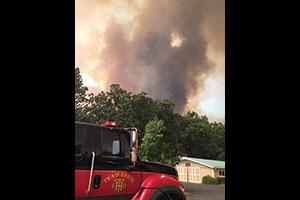
For a multitude of reasons, fire conditions during WUI incidents have intensified, especially in the past decade.
Once the concise augment of type and numbers of resources has been made, officers must be prepared to articulate the plan to these resources. A face-to-face briefing should always be the goal of any officer, but I know that isn’t always possible. The second best option is a complete articulation of all of the information over the radio, and that demands the commanding officer have a clear vision and excellent communication skills. A thorough and concise briefing is a skill that takes practice and effort. It is the foundation of the common operating picture that all command officers should be striving to establish and maintain for the duration of the incident with all resources under their command.
As a part of the initial and ongoing incident management, the first-commanding officer should develop alternatives to the current plan should adjustment be needed or conditions and effectiveness change. There are many reasons a plan must change, and there is no failure in that. The only failure is not planning for viable alternatives at the beginning. I encourage all officers to remember primary, alternate, contingency, emergency (PACE). PACE is a great reminder of the layers of planning and communications all those in command should strive for to always have coordinated response to changing conditions.
Recognize/React/Reevaluate
For a multitude of reasons, fire conditions during WUI incidents have intensified, especially in the past decade. Our wildland fuels and encroachment of development into the wildland have reached a critical mass and are releasing massive amounts of energy when burning. The window of opportunity to safely and effectively implement action has narrowed, and the first-arriving command needs to take this into consideration. All personnel need to be able to recognize changing conditions with a positive safety margin and have a reliable exit path should it be required. The fire environment has fundamentally changed with the deadly combination of increased fuel loading, prolonged drought, and continued development in the WUI. The problems for fire personnel associated with the facts of new fire environment are numerous but are not ones we can change. The only mitigating factor to this increased hazard is recognition. If all officers who are in command of a WUI incident take the time and effort to develop solid SA and maintain it with current and incident relevant information, the likelihood of missing a critical change in fire activity is reduced.
All in command positions need to have a plan they can implement to react to the change in the incident. Officers must develop the habit of constant processing of the status, safety, and effectiveness of the tactics and always reevaluate. Now more than ever, WUI incident are exploding and forcing command to be more tactically flexible. Officers must see the conditions change, react appropriately with predetermined responses, and reevaluate the safety and effectiveness of all assigned personnel.
Critical Thinking
I cannot overemphasize the need to have all officers in command engaged in critical thinking. For the safety of the public and incident personnel, command must always strive to be mentally ahead of the fire’s next move. This will be achieved if those currently or aspiring to be in a command position during a WUI incident are knowledgeable about the wildland fire environment and the factors that influence fire behavior.
It is our responsibility as officers to lead by example and demonstrate a safety culture through our command decisions. We need to show the next generation of fire personnel what it means to perform effective risk management and be ethically engaged.
 Todd McNeal is a 23-year veteran of the fire service and chief of Twain Harte Fire in Tuolumne County, California. He has a diverse background in wildland and structural fire management and suppression and has been serving as a division/group supervisor on a Federal Type II Incident Management Team for 10 years. McNeal has been an instructor in the fire service for 15 years, holds numerous ICS qualifications in wildland operations, is a registered instructor with California State Fire Training and a California fire officer, and has a bachelor’s degree in natural resource management.
Todd McNeal is a 23-year veteran of the fire service and chief of Twain Harte Fire in Tuolumne County, California. He has a diverse background in wildland and structural fire management and suppression and has been serving as a division/group supervisor on a Federal Type II Incident Management Team for 10 years. McNeal has been an instructor in the fire service for 15 years, holds numerous ICS qualifications in wildland operations, is a registered instructor with California State Fire Training and a California fire officer, and has a bachelor’s degree in natural resource management.

